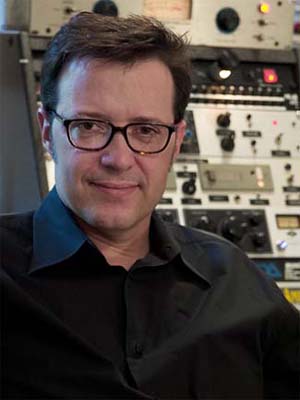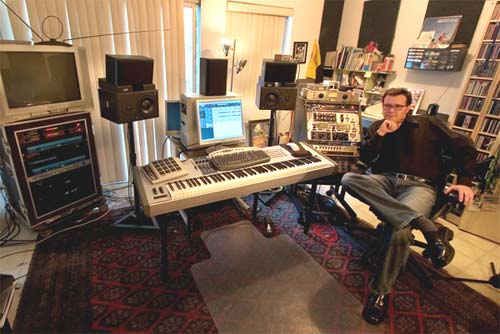Volume 3, Number 2, April 2005
[UA Universe] [Ask the Doctors] [Digital Minds] [Analog Obsession]
[Support Report] [The Channel] [Plug-In Power] [Analog Ears] [Featured Promotion]
[Graphic-Rich WebZine]
[Back Issues] [UA Home]
Analog Ears
Fred Maher – Inspired by the LA-610
Former Scritti-Politti and Material Member Rediscovers the Beauty of Analog
By Marsha Vdovin
 |
|
In the late 1990s, Fred Maher was using Pro Tools on a Mac. In 2002, he was working on Steinberg’s Nuendo on a PC
|
Fred also produces, composes and mixes, and he is an A&R consultant for the entertainment division of DTS. His home studio boasts four PCs, all from AMD. His main machine is an AMD Duel Opteron PC with his main tool Nuendo and a UAD-1 card. Another machine is dedicated to Gigastudio, and another Dual Opteron is a server.
"All my audio lives on the server, and I have gigabit Ethernet connected to everything," Fred explains. "I can just pull all the audio and push off the server. It makes archiving and keeping everything straight and neat a lot simpler, because there's a dedicated machine with no applications on it. Everything is safe and sound."
Fred also runs another single-processor AMD with Nuendo and Cubase SX. This is a beta-testing machine that Fred uses to run tests for Steinberg, Waves and Wizoo. His stereo monitors are Dynaudio BM6As, and he has custom surrounds built by Ken Goerres, who also put together the surrounds in the DTS mastering room.
“I always use the LA-610 for vocals. I have two Soundelux U95s, which are not made anymore... I use them straight into the LA-610, and I almost always use the compressor to varying degrees”
The purchase of an LA-610 recently inspired Fred to revamp his studio. He pulled some other vintage gear out of storage: a Telefunken B 72, a Calrec PQ14S, and a mid-'70s Class A channel strip from a Calrec console-very similar to a Neve 1073 module.
"Getting the LA-610 inspired me to get them out and put a rack together," Fred recalls. "I am an amateur guitar player, but I become a professional guitar player after I edit it. I also dug out all my pre-pod technology: a Custom Audio Electronics +3 analog tube guitar preamp by Bradshaw, a Marshal JMP1, a Boogie Formula Pro, and an ADA MicroCab II cabinet simulator. Each one of those devices has a cabinet simulator out, or just a straight out that is meant to go to a speaker cabinet. Then I have a speaker cabinet emulator from ADA. I put it all it into a little patchbay so I can move the sound around. I can put it through the LA-610 or through the Calrec first, and then the LA-610 or through the guitar preamps."
Fred may be an "amateur guitar player," but he began his career as a world-class drummer. He dropped out of high school at age sixteen to tour with the band Material, which also included Beinhorn and bass player Bill Laswell. At the age of eighteen, Fred was recording with Lou Reed and taking classes at one of the New York City's most prestigious art schools, Cooper Union. A year later, he chose playing music over school and became part of the hit group Scritti Politti. From there, he moved on to be a prolific programmer, composer, engineer, and producer. One of Fred's various projects includes producing and engineering for singer/songwriter Jennifer Crowe.
"I always use the LA-610 for vocals," he says. "I have two Soundelux U95s, which are not made anymore. I was lucky enough to get a serial-number matched pair. I use them straight into the LA-610, and I almost always use the compressor to varying degrees, depending on what I want. I tend to use the mic using the 2k impedance setting. On Jenn's vocals, I can run the preset gain at zero with no pads, in phase, no phantom power. With her, I'll use a little low roll-off at 70 just to get the room out, which is very handy when you are literally in a room.
"I don't have a vocal booth, so depending on what the track calls for, I might record it with a tiny bit of gain reduction. Sometimes if we are going for a sound, I'll hit it a little harder. What I like about the LA-610 is that it's super clean, super warm. And although it is based on very old-school technology, you can get some very modern sounds out of it. It will give some squishy, squashy compression like a more modern compressor if you want, but it can also be very subtle and LA-2A-like.
 |
|
Fred Maher in his home studio. Photo by Martin Stahl
|
The UAD-1 has been a vital ingredient to Fred's mixes. "The Pultec Pro is ridiculous, and the1176 actually sounds like an 1176--which I know because I have one, although I don't have it set up in studio right now," he says. "I know the 1176 really well, and the UAD-1 emulation is perfect."
"The Plate 140 is my new favorite. It's remarkable. With, plug-in reverbs the presets are usually way too splashy and they have all this high-end response that I guess people think is really cool. When I got the Plate 140, I was in heaven to hear that warm, tanky, classic sound. It was awesome."
Fred is also working on film soundtracks with a young upstart director, Tito DeCosta. They just completed their third project together. "One was a 'Twilight Zone,' freaky, murder mystery, out-of-body thing that had no dialog," he explains. "There were lots of hyper-specific cues. It was like a really fast paced version of Repulsion. There were lots of specific moody cues that ended up in a slamming Aphex Twin, 'come to Daddy' thing.
"I use Gigasampler and I recently got Atmospheres from Spectrasonics," Fred continues. "Another tool I've been using is the CYCLES series from Cycling 74. It's a set of audio libraries that were created by Ron MacLeod, a brilliant sound designer that the created the 'A Poke in the Ear With a Sharp Stick' series that originally came out in the early '90s. Not only are they a fantastic resource for finding that 'special something' that might be missing from a cue or interstitial for a film, they are in surround as well as stereo. I do a lot of surround work, and this is the only series of its type that's presented in the 5.1 format."
Another project that Fred recently did was a surround mix of the Crystal Method album Legion of Boom: "When I was mixing Crystal Method, my friend Martin Stahl from Steinberg lent me the Steinberg ID control surface. It was great for mixing an entire album. They made it really easy. Certain projects, it really makes a difference."